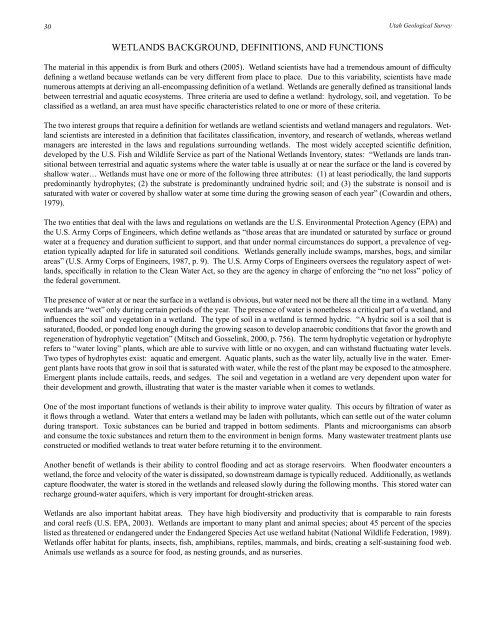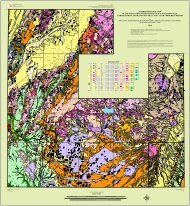Wetlands in northern Salt Lake Valley, Salt Lake County, Utah
Wetlands in northern Salt Lake Valley, Salt Lake County, Utah
Wetlands in northern Salt Lake Valley, Salt Lake County, Utah
You also want an ePaper? Increase the reach of your titles
YUMPU automatically turns print PDFs into web optimized ePapers that Google loves.
30<strong>Utah</strong> Geological SurveyWETLANDS BACKGROUND, DEFINITIONS, AND FUNCTIONSThe material <strong>in</strong> this appendix is from Burk and others (2005). Wetland scientists have had a tremendous amount of difficultydef<strong>in</strong><strong>in</strong>g a wetland because wetlands can be very different from place to place. Due to this variability, scientists have madenumerous attempts at deriv<strong>in</strong>g an all-encompass<strong>in</strong>g def<strong>in</strong>ition of a wetland. <strong>Wetlands</strong> are generally def<strong>in</strong>ed as transitional landsbetween terrestrial and aquatic ecosystems. Three criteria are used to def<strong>in</strong>e a wetland: hydrology, soil, and vegetation. To beclassified as a wetland, an area must have specific characteristics related to one or more of these criteria.The two <strong>in</strong>terest groups that require a def<strong>in</strong>ition for wetlands are wetland scientists and wetland managers and regulators. <strong>Wetlands</strong>cientists are <strong>in</strong>terested <strong>in</strong> a def<strong>in</strong>ition that facilitates classification, <strong>in</strong>ventory, and research of wetlands, whereas wetlandmanagers are <strong>in</strong>terested <strong>in</strong> the laws and regulations surround<strong>in</strong>g wetlands. The most widely accepted scientific def<strong>in</strong>ition,developed by the U.S. Fish and Wildlife Service as part of the National <strong>Wetlands</strong> Inventory, states: “<strong>Wetlands</strong> are lands transitionalbetween terrestrial and aquatic systems where the water table is usually at or near the surface or the land is covered byshallow water… <strong>Wetlands</strong> must have one or more of the follow<strong>in</strong>g three attributes: (1) at least periodically, the land supportspredom<strong>in</strong>antly hydrophytes; (2) the substrate is predom<strong>in</strong>antly undra<strong>in</strong>ed hydric soil; and (3) the substrate is nonsoil and issaturated with water or covered by shallow water at some time dur<strong>in</strong>g the grow<strong>in</strong>g season of each year” (Coward<strong>in</strong> and others,1979).The two entities that deal with the laws and regulations on wetlands are the U.S. Environmental Protection Agency (EPA) andthe U.S. Army Corps of Eng<strong>in</strong>eers, which def<strong>in</strong>e wetlands as “those areas that are <strong>in</strong>undated or saturated by surface or groundwater at a frequency and duration sufficient to support, and that under normal circumstances do support, a prevalence of vegetationtypically adapted for life <strong>in</strong> saturated soil conditions. <strong>Wetlands</strong> generally <strong>in</strong>clude swamps, marshes, bogs, and similarareas” (U.S. Army Corps of Eng<strong>in</strong>eers, 1987, p. 9). The U.S. Army Corps of Eng<strong>in</strong>eers oversees the regulatory aspect of wetlands,specifically <strong>in</strong> relation to the Clean Water Act, so they are the agency <strong>in</strong> charge of enforc<strong>in</strong>g the “no net loss” policy ofthe federal government.The presence of water at or near the surface <strong>in</strong> a wetland is obvious, but water need not be there all the time <strong>in</strong> a wetland. Manywetlands are “wet” only dur<strong>in</strong>g certa<strong>in</strong> periods of the year. The presence of water is nonetheless a critical part of a wetland, and<strong>in</strong>fluences the soil and vegetation <strong>in</strong> a wetland. The type of soil <strong>in</strong> a wetland is termed hydric. “A hydric soil is a soil that issaturated, flooded, or ponded long enough dur<strong>in</strong>g the grow<strong>in</strong>g season to develop anaerobic conditions that favor the growth andregeneration of hydrophytic vegetation” (Mitsch and Gossel<strong>in</strong>k, 2000, p. 756). The term hydrophytic vegetation or hydrophyterefers to “water lov<strong>in</strong>g” plants, which are able to survive with little or no oxygen, and can withstand fluctuat<strong>in</strong>g water levels.Two types of hydrophytes exist: aquatic and emergent. Aquatic plants, such as the water lily, actually live <strong>in</strong> the water. Emergentplants have roots that grow <strong>in</strong> soil that is saturated with water, while the rest of the plant may be exposed to the atmosphere.Emergent plants <strong>in</strong>clude cattails, reeds, and sedges. The soil and vegetation <strong>in</strong> a wetland are very dependent upon water fortheir development and growth, illustrat<strong>in</strong>g that water is the master variable when it comes to wetlands.One of the most important functions of wetlands is their ability to improve water quality. This occurs by filtration of water asit flows through a wetland. Water that enters a wetland may be laden with pollutants, which can settle out of the water columndur<strong>in</strong>g transport. Toxic substances can be buried and trapped <strong>in</strong> bottom sediments. Plants and microorganisms can absorband consume the toxic substances and return them to the environment <strong>in</strong> benign forms. Many wastewater treatment plants useconstructed or modified wetlands to treat water before return<strong>in</strong>g it to the environment.Another benefit of wetlands is their ability to control flood<strong>in</strong>g and act as storage reservoirs. When floodwater encounters awetland, the force and velocity of the water is dissipated, so downstream damage is typically reduced. Additionally, as wetlandscapture floodwater, the water is stored <strong>in</strong> the wetlands and released slowly dur<strong>in</strong>g the follow<strong>in</strong>g months. This stored water canrecharge ground-water aquifers, which is very important for drought-stricken areas.<strong>Wetlands</strong> are also important habitat areas. They have high biodiversity and productivity that is comparable to ra<strong>in</strong> forestsand coral reefs (U.S. EPA, 2003). <strong>Wetlands</strong> are important to many plant and animal species; about 45 percent of the specieslisted as threatened or endangered under the Endangered Species Act use wetland habitat (National Wildlife Federation, 1989).<strong>Wetlands</strong> offer habitat for plants, <strong>in</strong>sects, fish, amphibians, reptiles, mammals, and birds, creat<strong>in</strong>g a self-susta<strong>in</strong><strong>in</strong>g food web.Animals use wetlands as a source for food, as nest<strong>in</strong>g grounds, and as nurseries.
















